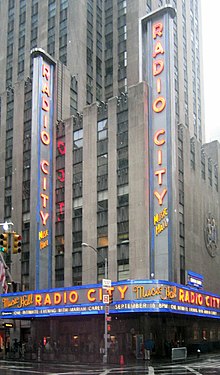Radio City Music Hall



Radio City Music Hall is a premier entertainment venue located in New York City's Rockefeller Center. Its nickname is the Showplace of the Nation, and it was for a time the leading tourist destination in the City. Its interior was declared a City landmark in 1978.
Early history
The 12 acre (49,000 m²) complex in midtown Manhattan known as Rockefeller Center was developed between 1929 and 1940 by John D. Rockefeller, Jr., on land leased from Columbia University. Rockefeller initially planned an opera house on the site, but changed his mind after the Stock Market Crash of 1929.
The names "Radio City" and "Radio City Music Hall" derive from one of the complex's first tenants, the Radio Corporation of America. Radio City Music Hall was a project of Rockefeller, Samuel Roxy Rothafel who previously opened the Roxy Theater in 1927, and RCA chairman David Sarnoff. RCA had developed numerous studios for NBC at 30 Rockefeller Plaza, just to the south of the Music Hall, and the radio-TV complex that lent the Music Hall its name is still known as the NBC Radio City Studios.
The Music Hall opened to the public on December 27, 1932 with a spectacular stage show, featuring Ray Bolger and Martha Graham. The opening was meant to be a return to high class variety entertainment. Unfortunately, it was not a success and on January 11 1933, the first film was shown on the giant screen: The Bitter Tea of General Yen starring Barbara Stanwyck.
Radio City has 5,933 seats for spectators; it became the largest movie theater in the world at the time of its opening. Designed by Edward Durell Stone, the interior of the theater, by Donald Deskey, incorporates glass, aluminum, chrome, and geometric ornamentation. Deskey rejected the Rococo embellishment generally used for theaters at that time in favor of a contemporary Art Deco style, borrowed heavily from a European Modern aesthetic style, of which he was the foremost exponent at the time.
For much of the theater's history, it presented both a movie and a stage show as part of the same program. By the 1970s, changes in film distribution made it difficult for Radio City to secure exclusive bookings of many films; furthermore, the theater preferred to show only G-rated movies, which became less common as the decade wore on. Regular film showings at Radio City ended in 1979, although movies have occasionally been shown there in succeeding years.
Attractions
The Great Stage, measuring 66.5 feet (20 m) deep and 144 feet (44 m) wide, resembles a setting sun. Its system of elevators was so advanced that the U.S. Navy incorporated identical hydraulics in constructing World War II aircraft carriers. According to Radio City lore, during the war, government agents guarded the basement to assure the Navy's technological advantage.
The Music Hall's Mighty Wurlitzer pipe organ is the largest theater pipe organ built for a movie theater. Twin identical consoles flank both sides of the Great Stage, 144 feet apart. As it was installed in 1932, the instrument, the largest produced by the Rudolph Wurlitzer Manufacturing Company of North Tonawanda, New York, was not built to accompany silent movies, but rather to be a concert instrument, capable of playing many styles of music, including classical organ literature. Its 4,410 pipes are installed in chambers on either side of the proscenium's arch. A restoration of the historic organ was undertaken that was completed in time for the theater's restoration in 1999. A smaller Wurlitzer organ was installed in the theater's radio studios, but was put into storage when the studio was converted into office space.
The theater is also home to the Radio City Christmas Spectacular, a New York Christmas tradition since 1933, and to the women's precision dance team known as The Rockettes. The theater, which is managed by Cablevision, is also used for a variety of concerts and special events.
The Music Hall is the regular home of the Daytime Emmy Award ceremony (though the 2006 show were held in Los Angeles) and the Tony Awards, is the frequent site of the annual MTV Video Music Awards (although the ceremony has occasionally been held since the 1990s in Los Angeles and Miami), and has often been the venue for the Grammy Awards on years when New York has won the bid to host the show, although Madison Square Garden, owned by Cablevision, hosted the Grammys in 2003 while the Staples Center in Los Angeles most recently hosted the awards in 2007. In addition, Radio City Music Hall is also the regular home of commencement ceremonies for Hunter College and Pace University's New York City campus. The Great Stage has been home for the NFL Draft in 2006 and will again host the activities in 2007.
On January 15, 2000, Radio City Music Hall played host to its first ever sports event, a boxing card that featured undisputed light heavyweight champion Roy Jones, Jr. defeating David Telesco in the main event, and in the co-feature heavyweight David Izon defeating Derrick Jefferson.
The New York Liberty played some of their 2004 home games at Radio City while Madison Square Garden was renovated for the Republican National Convention.
Further reading
- Okrent, Daniel. Great Fortune: The Epic of Rockefeller Center, New York: Viking Press, 2003.
- Roussel, Christine. The Art of Rockefeller Center, New York: W.W. Norton & Company, 2006.
